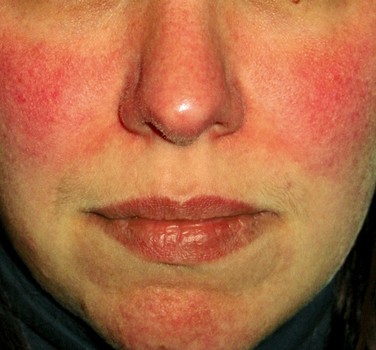

MedFriendly®


Windburn
Windburn is redness of the skin caused by exposure to
strong and cold winds for extended periods of time.This
happens because the irritation caused by cold wind and
the speed of the wind in low humidity removes a thin
layer of fat molecules (oil) from the skin that normally
moisturizes it and helps filter the ultra-violet rays of the
sun.
The skin is dryer in the cold air which allows the wind to
break down the fat molecule layer more easily. This, in
turn, makes the skin more susceptible to harm. This
effect increases with stronger and colder winds.
FEATURED: Skin Rules: Top Secrets from a Top New
Windburn can cause
redness of the face that
looks like sunburn.
Windburn can occur on both sunny and cloudy days because even on cloudy days there
can be glare from the sun. Windburn can occur when it is snowy outside because the
sun can reflect back 80% of ultraviolet rays off the snow. Some have argued that
windburn is only caused by the drying effects of the wind but others argue that sunburn
also contributes to the redness of the skin (combined with the drying effects of the
wind).
WHAT ARE SIGNS AND SYMPTOMS OR WINDBURN?
In windburn, irritation of the skin is usually characterized by redness of the face
although other areas can also be affected such as the neck and hands. Windburn can
look and feel like sunburn (e.g., red hot, dry, and painful skin that sometimes peels off).
Sometimes, the skin can seem swollen and feel very itchy and/or sore. Windburn
usually does not last as long as sunburn (typically only a few days) because it causes
help to make sure it is not another skin condition such as rosacea, which can mimic
windburn. Rosacea is a skin disease characterized by various forms of facial redness
due to enlargement and widening of blood vessels beneath the surface of the skin.
WHO IS MOST LIKELY TO EXPERIENCE WINDBURN?
People exposed to cold, dry, windy weather are most likely to experience windburn. People who are
involved in winter sports are especially vulnerable to windburn such as snowboarders, skiers, and ice
skaters. This is because these people are moving around in the wind and sun more. Any exposure to
cold, dry, brisk winds at high altitudes increases the possibility of severe windburn. People who live in
warm climates do not usually experience windburn because they are not usually exposed to the cold
dry air that causes it. However, they can experience windburn if they are suddenly exposed to cold dry
winds on vacation or during an abrupt weather change.
HOW IS WINDBURN PREVENTED?
Preventing windburn is similar to preventing sunburn. This includes wearing protective sunscreen (at
least 15 SPF) and non-irritating moisturizers because they will provide the layer of moisture needed to
protect it from the wind. Lip balm (petroleum or beeswax that includes sunscreen) can also be helpful in
this regard because the lips are very vulnerable to the effects of wind. These products can be applied
every few hours. It is important to avoid using products that remove oils from the skin that dry it out
such as certain anti-wrinkle creams that contain retinal (a form of vitamin A), salicylic acid, and anti-
hydroxy acids. Moisturizers can be applied three to four times a day. The best moisturizer is petroleum
jelly but it does not look nice cosmetically. Therefore, people generally use more cosmetically appealing
moisturizers.
Avoiding skin treatments before exposure to the wind and sun would also help prevent windburn.
Examples include avoiding chemical skin peels or microdermabrasion. Microdermabrasion involves the
use of tiny rough grains to remove the surface layer of the skin. Not shaving or washing your face
before exposure to cold winds can help prevent windburn because washing and shaving removes
some of the oil layer of the skin that protects it against windburn.
Covering exposed areas of skin with clothing also helps prevent windburn. This includes use of a winter
hat, gloves, a scarf to cover the lips, neck, and chin, ear muffs or a headband to cover the ears,
sunglasses/goggles (with ultraviolet ray protection), or even a ski mask that covers the entire face,
particularly if participating in recreational activities. Some people recommend a terry-cloth towel as
opposed to a wool scarf to protect the neck because the wool scarf is more irritating and absorbent.
A cotton turtleneck (as opposed to one made of synthetic fiber) is another option to protect the neck.
There is tender skin under the neck and chin that should be protected since they can easily be affected
by light reflected from the snow. Reducing exposure to extremely cold temperatures (less than 20
degrees Fahrenheit) for long periods of time is also advisable.
HOW IS WINDBURN TREATED?
A Dermatology Clinic is an excellent resource for windburn treatment advice. Treatment of windburn
includes moisturizing the skin with products such as aloe vera, several times a day. Such products
should be fragrance-free to reduce irritation. Pain medications, aspirin, ibuprofen, and anti-inflammatory
medicines can help to improve the healing process. If they eyes were affected, eye drops can be used
to moisturize them. Lip balm can be used to treat dry lips. Doctors typically advise staying away from
hot showers for a few days and from keeping affected areas of the skin away from heaters or fires.
Doctors advise not to pick at peeling skin. When cleaning the skin, using mild cleansers can help retain
natural oils on the skin. Blistery and swollen skin should be evaluated by a doctor.















